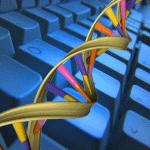Bioinformatics
|
23 may 2015 09:53:16 |
| Probing long-range interactions by extracting free energies from genome-wide chromosome conformation capture data (BMC Bioinformatics) |
|
Tweet Background:
A variety of DNA binding proteins are involved in regulating and shaping the packing of chromatin. They aid the formation of loops in the DNA that function to isolate different structural domains. A recent experimental technique, Hi-C, provides a method for determining the frequency of such looping between all distant parts of the genome. Given that the binding locations of many chromatin associated proteins have also been measured, it has been possible to make estimates for their influence on the long-range interactions as measured by Hi-C. However, a challenge in this analysis is the predominance of non-specific contacts that mask out the specific interactions of interest.
Results:
We show that transforming the Hi-C contact frequencies into free energies gives a natural method for separating out the distance dependent non-specific interactions. In particular we apply Principal Component Analysis (PCA) to the transformed free energy matrix to identify the dominant modes of interaction. PCA identifies systematic effects as well as high frequency spatial noise in the Hi-C data which can be filtered out. Thus it can be used as a data driven approach for normalizing Hi-C data. We assess this PCA based normalization approach, along with several other normalization schemes, by fitting the transformed Hi-C data using a pairwise interaction model that takes as input the known locations of bound chromatin factors. The result of fitting is a set of predictions for the coupling energies between the various chromatin factors and their effect on the energetics of looping. We show that the quality of the fit can be used as a means to determine how much PCA filtering should be applied to the Hi-C data.
Conclusions:
We find that the different normalizations of the Hi-C data vary in the quality of fit to the pairwise interaction model. PCA filtering can improve the fit, and the predicted coupling energies lead to biologically meaningful insights for how various chromatin bound factors influence the stability of DNA loops in chromatin. |
| 146 viewsCategory: Bioinformatics |
 Metabolic Needs and Capabilities of Toxoplasma gondii through Combined Computational and Experimental Analysis (PLoS Computational Biology) Metabolic Needs and Capabilities of Toxoplasma gondii through Combined Computational and Experimental Analysis (PLoS Computational Biology)NetworkPainter: dynamic intracellular pathway animation in Cytobank (BMC Bioinformatics) 
|
| blog comments powered by Disqus |
MyJournals.org
The latest issues of all your favorite science journals on one page
The latest issues of all your favorite science journals on one page



